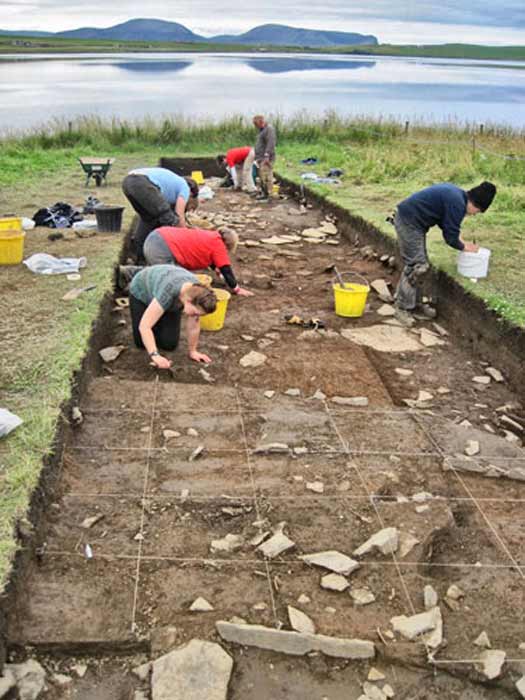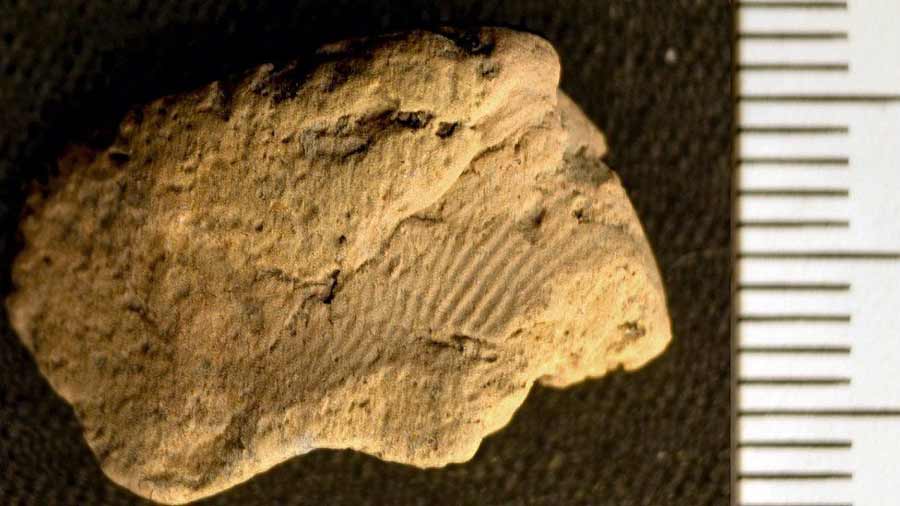Neolithic Fingerprints In Orkney Offer ‘Unparalleled Glimpse’ of Life
The Neolithic fingerprints of two young male potters have been identified on a 5,000-year-old fragment of clay discovered in Orkney.
In April this year The Press and Journal announced that archaeologists excavating at the Heart of Neolithic Orkney World Heritage Site discovered a “5,000 years old” finger print on the surface of a clay vessel. Someone at The Ness of Brodgar, a vast Neolithic cathedral-style complex, had pressed their finger into the wet clay surface and left an imprint according to The University of the Highlands and Islands (UHI) Archaeology Institute, who led the excavation.
At the time the Smithsonian said the discovery of the Neolithic fingerprint “illuminated an unparalleled glimpse” into life at the remarkable site during the period. But now, Professor Kent Fowler, director of the University of Manitoba ’s Ceramic Technology Laboratory in Winnipeg, Canada, has used a digital model of the clay, created by The Ness of Brodgar ceramic specialist Jan Blatchford, to reveal a further two ancient fingerprints belonging to two young men.

Work under way in Trench X where the pottery was found. (Ness of Brodgar)
Neolithic Fingerprints Tell Us More About Ancient People
The Ness of Brodgar is the name of the thin strip of land in the West Mainland of Orkney that separates the lochs of Harray and Stenness. The two Neolithic fingerprints were discovered on the same piece of 5,000-year-old pottery as the earlier one, and together they have revealed new details about the ancient people of Orkney, the archipelago northeast of Scotland, that has some of the most magnificent standing stone megalithic monuments in the world.
- Fingerprint found on ceramic bowl [in Denmark] is over 5,000 years old
- Orcadian Genesis: The Origins of the Orkney Isles’ Unique Megalithic Culture and its Roots in Britain’s Own Lost Atlantis – Part One
Nick Card, the director of the Ness of Brodgar excavation, told Orkney News that the new findings “put the people back into the story of the Neolithic landscape.” Professor Card said this one single sherd has brought two people “back into the spotlight.” And they have yielded an unparalleled glimpse into life at the Ness complex 5,000 years ago, added the researcher. Moreover, the archaeologist said that his teams of excavators have so far discovered “well over 80,000 pottery sherds . . . at the Ness of Brodgar, so it is all too easy to lose sight of the people behind the clay artifacts.”

Life-size sculpture of a prehistoric man or boy decorating a clay bowl (Juan Aunión / Adobe Stock)
Neolithic Fingerprints: Evidence of Working “Craft” Kids?
Professor Kent Fowler told The Scotsman that analysis of the Neolithic fingerprints on the clay fragment shows that one of the boys was been aged between 13 and 20, while the second boy was aged between 15 and 22 years old. Did both boys fashion the entire vessel? Or were they just involved in the manufacturing process? Perhaps the boy creator was overseen by a more experienced potter? These are some of the new questions that arise from the discovery of the two other Neolithic fingerprints discovered on the 5,000-year-old clay fragment.

The Neolithic fingerprint of an ancient Orkney ceramic artist or helper on a sherd of pottery recovered at The Ness of Brodgar excavation site in Orkney. (Jan Blatchford / The Ness of Brodgar)
Dr Fowler reminds us that we don’t yet know if all Neolithic children would have been engaged in the creation of pottery from an early age, or if pottery was a task that required only a few children? Maybe for intricate jobs, where the average adult finger was too bulky? But he also adds that it must be considered that different types of vessels may have been created by different people within the same community.

A child's right handprint on brown clay and yes the fingerprints are there too, just like the Neolithic fingerprints of the young pottery-making boys at The Ness of Brodgar, Orkney, Scotland nearly 5,000 years ago! (Denys / Adobe Stock)
Interior Print Made by Potter: Outside Prints By Handlers?
The professor told The Scotsman that "Ethnographic and experimental accounts of hand-building techniques indicate that hands are normally only placed within closed-form vessels when fashioning roughouts and while manipulating the object to modify the exterior by wiping, smoothing burnishing. external prints can accrue during shaping.”
- New Discoveries Show Child Labor is an Ancient Curse
- 1000 Ancient Sites Revealed by Aerial Scan of Scotland’s Arran Island
However, fingerprints can also be made after the clay pots have been made when the material was still soft to the touch, before being fired.
While the researcher is quick to say much more analysis is required before any definite conclusions can be drawn, his initial analysis of the fragment suggests that in the case of the three Neolithic fingerprints on the single Orkney clay fragment: “two were print makers and the interior print was left by the potter.”
Top image: An image of the fingerprint captured using Reflectance Transformation Imaging. Source: Jan Blatchford / The Ness of Brodgar
By Ashley Cowie



















